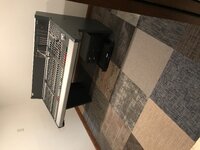Yes, a mixing console is a handy and more universally applicable tool in the studio IMO. It makes sense to acquire it first before the tape machine if you’re staggering the acquisition.
Yes you need a mixer for the A8, not a “desk”, just a console…the term “desk” as it applies to a mixing console is technically a larger console that has its own support legs or is otherwise on its own stand vs. being a tabletop console; one that you sit at like an actual desk…you certainly could get a larger format mixing desk to interface an A8, but it’s not necessary unless you have a large number of sources to sub-mix to the 8 tracks during tracking and overdubbing. Otherwise most consoles of at least 8 or more channels will do, and it’s particularly helpful if there are also multichannel monitoring facilities onboard. The M-30 fits this bill. Here is my Studer mixing “desk”:
View attachment 138203
Yes…I know I’m being language-retentive. I see people use the term “desk” for tiny mixers frequently and I don’t say anything. I’m saying something here simply to make the point you don’t need a larger format console to get the job done.
Anyway, honestly if I was you I would look at the Fostex Model 80 or R8 rather than the A8. They will be sonically very similar, but the A8 is the oldest and hardest to find of the trio, have lesser community support, will likely need greater TLC at this point just due to age, and only offers a maximum of 4 track simultaneous record whereas the other two have up to 8 track simultaneous record. The A8 has 8 tracks, but can only record a maximum of 4 at a time. All three are small 7” reel 1/4” 8-track format machines running at 15IPS. The Model 80 may be the sweet-spot, newer and more advanced than the A8, but not as impacted by some design “value engineering” that was implemented on the R8. Any of them are fine, but if I was looking for a 1/4” 8-track Fostex machine I’d be hunting for an 80.
Yes you would notice, generally, a fidelity difference between a 244 project and something done on a 1/4” 8-track 15IPS machine. Either can sound like garbage depending on the condition and setup of the machines; the capabilities of the engineer. Cassette 4-track projects can also sound really nice…”really nice” is according to the ear of the beholder of course and it’s a wildly subjective topic that people try to quantify using specifications which I think is dumb. We all know there is a more limited frequency range and headroom on a 4-track cassette machine compared to anything that is “more” (either wider track width or faster transport speed or something in the digital domain, for instance). But most cassette 4-track systems I would not call “lo-fi”, to the disagreement of many, either critics OR people that are seeking a “lo-fi” sound and think you have to have a cassette multitrack machine to do it.
@famous beagle posted some stuff here on this forum in years past he and his wife multitracked to a 414mkII IIRC that, to my ears, sounds *amazing*…lush and full and very not “lo-fi”; a great example of what is possible. And I myself was part of a project in the early 1990s that was tracked to a 488mkII 8-track cassette-based machine that, with a substantial amount of care and attention at each stage of the process, ended up sounding like something you would not expect was tracked on an 8-track Portastudio. It generally depends on your goals and capabilities how your project is going to turn out and less so on the equipment IMO. BUT…your open-reel consideration has greater potential because of the transport speed as well as greater options in tape formulations/operating level. The track width on the 244 is just under 0.020”, and the Fostex 1/4” 8-track format is actually a little more narrow at right around 0.017”. But the Fostex operates at 15IPS which is quadruple the Tascam at 3.75IPS.

